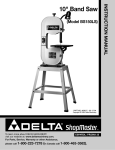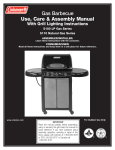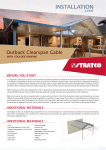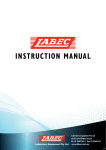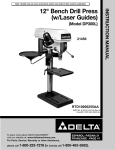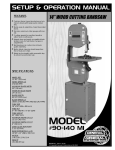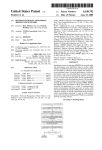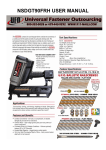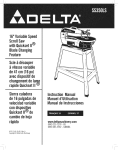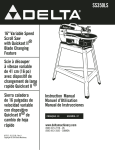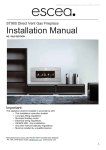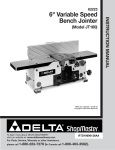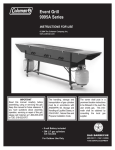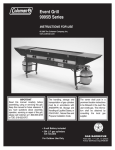Download Delta 36-322L Operating instructions
Transcript
the An Exclusive Lowe’s Woodworkers Publication woodpost Summer 2006 entertain anywhere with this multiuse table Enjoy this complimentary issue of Lowe’s The Wood Post magazine. To sign up for your FREE membership, see details on the back cover. 8 Router Table 11 Garden Bridge 13 Delta Woodworking Tools 18 Workshop Safety Bill Sawyer, Lowe’s Woodworkers table of contents The Pros Know 3 Multiuse Table 4 Router Table 8 Garden Bridge 11 The Right Tools 13 Workshop 19 Member Profile 19 Put It Together 20 P.S. Tell us about your projects or how you became interested in woodworking. Send your responses c/o Sandy Culver, P.O. Box 523, Birmingham, AL 35201. If we profile you in an upcoming issue of The Wood Post, you’ll receive a free Hitachi 14.4-volt 3⁄8-inch cordless drill/driver kit. FREE TO MEMBERS! As a member of Lowe’s Woodworkers, you are entitled to a free woodworking plan with each issue of The Wood Post. Try out our plan for this tile-top table (shown at left). It’s perfect for your outdoor space and is available online until August 14, 2006. Log on to Lowes.com/FreePlan. PHOTOGRAPH: JOHN O’HAGAN SAFETY IS YOUR RESPONSIBILITY: Lowe’s Companies, Inc., and its subsidiaries (“Lowe’s”), and SPC Custom Publishing, the Publisher of this issue of The Wood Post, have made every effort to be complete and accurate in the instructions and other content contained in this Publication. However, neither Lowe’s nor the Publisher assumes any responsibility or liability for damages or losses suffered, sustained, or incurred in the course of your home improvement, woodworking, or repair project or in the course of your use of the item you create or repair. Further, improper use of handtools or power tools can lead to serious and permanent injury or even death. In some issues of The Wood Post, the guards and safety equipment have been removed in illustrations and photos only to provide a better view of the operation of the tool. Do not attempt any procedure or project unless all guards and safety equipment are in place. Always follow manufacturer’s operating instructions in the use of tools. Check and observe all standard safety precautions. 2 Summer 2006 Q&A With the Experts at Q Are there particular instances when I should and should not predrill to assemble projects with nails and screws? A: You can almost never go wrong predrilling for assembly when using either nails or screws. As long as the hole that you drill is slightly smaller than the diameter of your fastener, you’ll find that the fastener will go in more easily and accurately. In some instances, however, it’s imperative that you predrill. If you don’t predrill when you’re driving a fastener into the end of a board, for instance, the fastener most likely will cause the end to split. Likewise, if you’re screwing or nailing into the edge of a board, predrilling prevents the fastener from splitting the workpiece along its edge. Finally, some engineered materials, particularly particleboard and medium-density fiberboard (MDF), require predrilling; if you skip this important step, the edges certainly will split. Q When I use my router, I often get dark marks on the edge of the piece that I’m routing. Is there a technique that I can use to prevent this from happening? A: The dark marks that you’re experiencing are most likely burn marks caused by excessive friction. When there’s too much friction, it creates overheating, which can burn or scorch wood fibers. Friction can occur when using too slow a feed rate, a dull bit, or the wrong type of pilot (for piloted bits). A feed rate that’s too slow allows a sharp bit to rub against the wood fibers enough to cause burning. A dull bit has a tendency to tear wood fibers; because it doesn’t cut cleanly, you generally have to slow the feed rate, which contributes to the problem. Use a sharp bit and a moderate feed rate, and the burn marks should go away. Although most burn marks are caused by the bit’s cutting edge, the pilot (if you’re using a piloted bit, such as a rabbeting bit) also can be the culprit. The pilot may have either a ball bearing or a rub collar. For the most part, a ball-bearing guided bit leaves no burn marks because the bearing rolls along the wood surface, allowing the bit to spin independently. Rub collars by their very nature cause burning during a slow feed rate. To eliminate this problem, replace rub collars with ball bearings. Finally, it’s important to note that some wood types have a reputation for burning, even with a sharp bit and moderate feed rate. For the best results, make a series of light cuts rather than one full-depth cut. Q Sometimes I need multiple pieces cut to the same size for a project. Can I do this efficiently, and accurately, without cutting one piece at a time? A: Production shops use a simple technique known as gang cutting to cut multiple identical workpieces quickly and accurately. Whether you’re using a miter, table, band, or scroll saw, stack two or more workpieces on top of one another for the cut. On a table saw, push the stacked parts past the blade using the miter gauge. With a miter saw, press the stack right up against the fence, and lower the blade. In either case, be sure to use some form of a stop to keep individual pieces from shifting during the cut; just make sure that the stop is as tall as your stacked pieces. For cuts on a band saw or scroll saw, your best bet is to attach the pieces of the stack temporarily with double-sided tape to keep them from shifting. One advantage of stacked cuts on the band or scroll saw is that you will need to affix only one pattern to the top piece to make the cut, rather than duplicating the pattern for each workpiece. n PHOTOGRAPH: JOHN O’HAGAN S ummer outdoor entertaining offers the chance to combine great food, great friends, and memorable experiences. Our multiuse table provides the perfect centerpiece for your favorite dishes, as well as a focal point for your guests. The project, a multipurpose adjustable table, is ideal for tailgating events and outdoor concerts, plus it can serve as a dining table. Its ability to collapse gives folks with limited space the option to have a large table for entertaining. Our garden bridge is a great outdoor project that makes a big impact on any landscape. Strolling across this piece will give you a sense of the craftsmanship that goes into a project that’s both decorative and functional. A router table is one way to make a highly versatile tool even more useful and help any woodworker achieve amazing results. This project makes it easier than ever to create decorative profiles and cut precise joinery. Speaking of joinery, in Put It Together we take a look at one of the strongest joints used in creating furniture—the mortise and tenon. In the Workshop column our tips on saw blades will help you maintain these vital accessories and give them a long life by keeping their edge. As always, please tell us about your woodworking projects—what you have created on your own or constructed from this issue, or any issue, of The Wood Post. Write to me with your comments and suggestions, or visit us online at Lowes.com/Woodworkers. © 2006 Lowe’s Companies, Inc. All rights reserved. Lowe’s and the gable design are registered trademarks of LF, LLC. Lowe’s Companies, Inc., is the owner of copyright in the design, layout, arrangement, and presentation of this publication and is the owner of the copyright in certain materials in this publication. None of these may be copied and reproduced in any manner or medium without the express written permission of Lowe’s Companies, Inc. © 2006 SPC Custom Publishing. All rights reserved. SPC Custom Publishing has published this issue of The Wood Post for Lowe’s Companies, Inc., and owns copyright in materials SPC Custom Publishing has authored and materials taken from or derived from Creative Ideas for Home and Garden, Southern Living, and Sunset magazines. None of these may be copied or reproduced in any manner or medium without the express written permission of SPC Custom Publishing. From Our Shop the pros know Gang cutting produces multiple identical workpieces. THE WOOD POST 3 feature project TOOL LIST Multiuse Table This project can play many roles in your outdoor and indoor entertaining activities. sturdy and adjustable table is a must-have for tailgating, outdoor meals at home, or summertime events such as open-air concerts. Our activity table offers needed flexibility for all these functions— and more—with its adjustable legs and a collapsible center. It also makes a terrific auxiliary dining or gaming table for folks with limited space. Simply tuck in the legs, fold the table in half, and store it away when not in use. You can finish the project with your favorite team’s colors for tailgating, or substitute oak for poplar and apply a stain for a more polished look. A Instructions: General: Cut all parts as you assemble the project, using the Cut List as a guide and adjusting as needed for fit. Attach all parts with glue and 6d finishing nails unless otherwise specified. Step 1: Build the skirt assemblies. Note that you will construct two assemblies from the two halves of the table. Refer to Figure 1 for placement. a. Cut the side skirts, end skirts, and center braces, and label the pieces for reference. b. Following the positioning and measurements shown in the side skirt layout in Figure 1, drill holes in the side skirts for the locking pins and leg assembly attachment. c. Attach one end skirt to the end faces of a pair of side skirts; repeat for the other half of the table. d. Attach two center braces to the opposite end faces of the side skirts; repeat. e. Check both assemblies for square by measuring diagonally, and attach temporary braces to maintain the square angles. f. Clamp and glue the center spacer to the outside bottom edge of one of the center braces. 4 Summer 2006 Step 2: Build the legs, and install the stiffeners. a. Attach two upper legs flush together, and then drill a 3⁄8-inch hole and a 1⁄4-inch hole through both pieces as shown; finish cutting per the upper leg detail. Repeat for the remaining upper legs. b. Clamp the upper legs to a work surface. Using a router with a 1 ⁄4-inch straight bit, rout a 1⁄4-inch slot into each (see the upper leg detail in Figure 2). c. Clamp the lower legs to a work surface. Using a router with a 1 ⁄4-inch straight bit, rout a 1⁄4-inch slot into each (see the lower leg detail in Figure 2). Also drill a 1⁄4-inch hole and cut a notch in each, as shown in the detail. d. Sand, and finish as desired prior to assembling the leg pieces. e. Apply self-adhesive sandpaper to the inside face of each upper leg assembly (see Figure 2, upper leg detail). Note: The sandpaper will help grip the lower leg in any position (especially when extended). f. Attach lower legs to upper legs using hex bolts, fender washers, and bar knobs as shown in Figure 2. g. Attach upper legs to side skirts using hex bolts, flat washers, flat nylon washers, and crown hex nuts as shown in Figure 2. h. Clamp a framing square onto a leg assembly to hold it square with its side skirt. Then, using the 1⁄4-inch hole in the side skirt as a guide, drill a 1⁄4-inch hole through the upper leg for the locking pin. Repeat with remaining leg assemblies. i. Temporarily thread a brass wing nut onto the locking pin to secure the legs in the folded-down position. Note: The locking bolt will secure the leg assembly when the table is closed for storage. j. Use a 1⁄16-inch nylon washer as a spacer between the outer faces of a pair of upper legs and the inner face of the first stiffener, with the stiffener resting on the shoulder of the legs (see Figure 3). k. Attach the stiffener to the side skirts. l. Attach a second stiffener to each side skirt and the face of the first stiffener so that the bottom edges of the stiffeners are flush. m. Repeat Steps 2j–2l for the second leg assembly. n. Attach the leg spacers to the lower legs at the locations shown in the lower leg detail in Figure 2. Step 3: Complete the top assembly, and add hardware. Note: See Figure 3 for placement. a. Cut the top panels per the Cut List. b. Scribe the long and short nosings, and miter cut to fit. Attach the nosings per Figure 3. c. Attach the top panels to the skirt/leg assembly, centering from side to side and aligning the edge of the top panel with the edge of the center braces. d. Attach the two halves of the table using a piano hinge (refer to Figure 3, piano hinge/sash lock detail). e. Attach the three sash locks under the tabletop, spacing them equidistant from each other. Be sure to place them proportionally for maximum stability. The sash locks will secure the tabletop in its extended position. Step 4: Apply a finish. a. Fill all nail holes, sand, and finish as desired. See the photographs on page 6 if you plan to stain your project. For our painted version of the table, we used American Tradition, Homecoming Blue #4009-9, semi-gloss). Project #SU061 I • table saw (or circular saw with a straightedge guide) • miter saw (or miter box and handsaw) • router with 1⁄4-inch straight bit • band saw (or jigsaw) • drill/driver and bits • power sander and various grits of sandpaper • framing square • clamps • tape measure • pencil LOWE’S LIST Lumber* • 1 (6-foot-long) 1 x 2, poplar • 2 (8-foot-long) 1 x 2s, poplar • 4 (2-foot-long) 1⁄2 x 3s, poplar • 4 (8-foot-long) 1 x 4s, poplar • 1 (10-foot-long) 1 x 4, poplar • 1 (48- x 96-inch) sheet of 3⁄4-inch-thick birch plywood Hardware & Supplies • 4 (3⁄8 x 3) hex bolts • 16 (1 x 13⁄32 x 1⁄16) flat nylon washers • 4 (3⁄8-inch) flat washers • 4 (3⁄8-inch) crown hex nuts • 8 (1⁄4 x 3) hex bolts • 4 (1⁄4 x 31⁄2) hex bolts • 1 package (1⁄4-inch) fender washers • 8 (1⁄4 x 20) bar knobs • 4 packages (1⁄4 x 20) brass wing nuts • 1 (11⁄2- x 30-inch) piano hinge • 1 box 6d bright finishing nails • 1 (6-ounce) tube stainable wood filler • wood glue • 3 sash locks • 1 (10-yard) roll self-adhesive sandpaper • 1 quart stain or paint PHOTOGRAPHS: JOHN O’HAGAN CUT LIST Part Name Material Size (in inches) Quantity side skirts end skirts center braces center spacer stiffeners upper legs lower legs leg spacers top panels long nosing short nosing (10-foot-long) 1 x 4 (8-foot-long) 1 x 4 (8-foot-long) 1 x 4 1x2 1x2 (8-foot-long) 1 x 4 (8-foot-long) 1 x 4 1 ⁄2 x 3 (3⁄4-inch) plywood (8-foot-long) 1 x 4 (8-foot-long) 1 x 4 ⁄4 x 21⁄2 x 2911⁄16 3 ⁄4 x 21⁄2 x 221⁄4 3 ⁄4 x 21⁄2 x 221⁄4 3 ⁄16 x 3⁄4 x 221⁄4 3 ⁄4 x 11⁄2 x 201⁄2 3 ⁄4 x 21⁄2 x 173⁄16 3 ⁄4 x 21⁄2 x 153⁄4 1 ⁄2 x 21⁄2 x 161⁄4 3 ⁄4 x 281⁄2 x 347⁄16 3 ⁄4 x 3⁄4 x 3515⁄16 3 ⁄4 x 3⁄4 x 30 4 2 4 1 4 8 4 4 2 4 4 3 *Availability varies by market. The 1⁄4-inch slot in each leg piece allows the height of the table to be adjusted. THE WOOD POST 5 Figure 3 Figure 1 3/8" hole 29 11/16" top assembly side skirt layout short nosing center of table end of table 1 7/16" 11/16" 13/16" 1/4" locking-pin hole (open position) 10 1/8" 6 1/2" 1/4" locking-pin hole (folded position) side skirt top panels center braces side skirt end skirt long nosing spacer 3/16" x 3/4" applied to one assembly only end skirt 1/16” spacer and two stiffeners skirt assembly 1/16” spacer and two stiffeners Figure 2 17 3/16" 3/8" hole 5/8" skirt / leg assembly leg spacers add sandpaper to this area on inside face 5/8" leg spacers 1/4" hole 1/4" wide slot 7/8" 2 1/2" 2 1/2" 1 1/4" 13/16" 7/8" 2 1/4" 11 3/4" 15 3/4" short nosing 7/8" piano hinge short nosing top panel top panel upper leg detail (8 required) side skirt 15 3/4" 1" x 3/4" notch 1 1/2" side skirt 4" leg spacer 7/8" 2 1/2" center braces 7/8" 1/4" hole 12" 5/8" center braces CL 1/4" slot 2 1/4" 7/8" lower leg detail (4 required) 3/16” x 3/4” spacer sash lock piano hinge / sash lock detail Step 2f 1/4" fender washer 1/4 x 20 bar knob upper leg 1/4 x 3 hex bolt lower leg 1/4" fender washer Step 2g 3/8" crown hex nut 1 x 13/32 x 1/16 flat nylon washers 3/8" flat washer 1/4 x 20 wing nut 1/4 x 3 1/2 hex bolt (locking pin) 3/8 x 3 hex bolt Finished Dimensions: Height: 18–30 inches Depth: 72 inches Width: 30 inches 6 Summer 2006 ABOVE, LEFT: Besides being painted, the activity table also can be stained. Here, we used Olympic, Golden Oak. If staining, be sure to substitute oak for the poplar. ABOVE: The lower legs of this table are adjustable from the full height of 30 inches down to 18 inches. LEFT: Sash locks along the centerline of the table stabilize the top when it is in the extended position. feature project a. To make the template, first measure the distance from the cutting edge of a 1⁄4-inch straight bit to the outside edge of the router base plate to determine its offset. b. Then cut a plywood square to measure 9 inches plus twice the router base offset plus 6 inches. c. Locate and draw centerlines on the template. Then lay out a square measuring 9 inches plus twice the offset, centered on these centerlines. d. Drill an access hole for a jigsaw within the square, and cut it out. e. To rout the recess in the top, set a 1⁄4-inch straight bit fitted in your router for a 1⁄4-inch-deep cut. Then center the template over the 7inch-square hole cut in the top assembly, and temporarily attach with screws. Now rout out the material along the inner edges of the template to create a 1⁄4-inch-deep recess around the 7-inch hole. Use a chisel to square up the corners of the routed area. f. For a general-purpose base plate, use a drill/driver with a 11⁄2-inch hole saw attachment to cut a hole in the center of the acrylic plate. Consider making several base plates with center holes cut in a variety of sizes for different bits. Router Table portable router by itself is a versatile tool. But you won’t know everything it can do until you mount your router to a table. When you flip a router upside down, mount it, and add fences, you basically turn it into a shaper: You’re able to cut joinery with precision and rout decorative profiles with ease. Our router table features independently adjustable sliding fences and a push bar that glides along a groove in the tabletop. By mounting your router to an acrylic base plate recessed into the table, you can lift the router up and out conveniently to change bits and make adjustments. A Instructions: General: Cut all parts as you assemble the project, using the Cut List as a guide and adjusting as needed for fit. Use glue and the appropriate length nails to attach all parts unless otherwise specified. Step 1: Build the fences. See Figure 1. a. Drill a 5⁄16-inch hole 11⁄4 inches in from each end of the slide bottom; center the holes lengthwise as shown. b. Attach two slide sides to the slide bottom per Figure 1. c. Drill a 5⁄16-inch hole 2 inches in from each end of the slide face. d. Center and attach a slide face from side to side on the slide assembly. e. Insert a bar knob and elevator bolt into the two holes in the slide face. f. Attach the face, face spacers, and face backs per Figure 1. This assembly attaches to the slide face with the elevator bolt. g. Repeat Step 1 to create a second fence. Step 2: Build the push bar. Note: The push bar is similar to the miter gauge on a table saw. It’s built just like the sliding fences in Step 1, except that the face is replaced with a sacrificial board, and it has a guide that fits in a groove in the tabletop. See Figure 2. a. To make the base of the push bar, repeat Steps 1b and 1d for the bar sides, bottom, and face. b. Using glue and screws, attach the guide 8 Summer 2006 to the bottom of the push bar assembly so that it is centered and perpendicular to the face. Rounding the corners slightly will help the guide slide smoothly in the tabletop. c. Attach the sacrificial board to the bar face using screws; with use, it will get chewed up and need to be rotated and/or replaced. Step 3: Build the top assembly. Note: Before you begin assembling the top, you’ll want to measure your router to verify that it will fit through a 7-inch-square hole; if it will not, modify the hole dimensions as needed. See Figure 3. a. Locate and draw centerlines on the subtop. Lay out a 7-inch square that’s centered on the centerlines. b. Drill an access hole within the square for a jigsaw, and then cut out the 7-inch square on the sub-top. c. On the mid-top, measure and mark a line 12 inches in from the long back edge per the layout detail. Measure and mark a line 9 inches in from each short edge as shown. These are the centerlines of the material that you’ll remove to form the slots. d. Drill a 11⁄4-inch hole at the intersections of the 9- and 12-inch centerlines on the mid-top. e. Use a framing square to locate the apex on either side of the 11⁄4-inch holes. Mark a line that extends from the apex to the back edge of the mid-top. f. Cut along these lines, and then remove the material to create the slots. g. Locate the center of the 12-inch line on the mid-top, and draw a line perpendicular to it. Then lay out a 7-inch square centered on the intersection of these lines. LEFT: The push bar guides stock routing and helps apply even pressure. RIGHT: The fences adjust via elevator bolts and grooves in the top assembly. PHOTOGRAPHS: JOHN O’HAGAN Simplify edges and joinery and expand your capabilities by mounting your router in this table. h. Drill an access hole for a jigsaw within the square, and then cut out the 7-inch square. i. Attach the mid-top to the sub-top so that the edges are flush. j. Attach the front edging to the top of the sub-/mid-top assembly so that the front edges are flush. k. Lay out the top as shown in the layout detail in Figure 3 (as in Step 3c). l. Repeat Step 3g on the top. m. Drill a 5⁄16-inch hole at the intersections of the 9- and 12-inch. n. Repeat Steps 3e and 3f to locate and cut slots in the top for the elevator bolts. o. Repeat Step 3h for the top. p. Attach the top to the sub-/mid-top assembly so that the sides and back edges are flush; this creates a 3⁄4-inch groove in the top assembly for the push bar. Step 4: Add the acrylic base plate. Note: To make it easy to change bits, you’ll replace the base plate on your router with a 9-inchsquare acrylic base plate that fits into the recess in the top assembly. This allows you to push the router and base plate up from underneath to set the router on the router table for bit changing. The most accurate way to rout this recess is to use a template. TOOL LIST • table saw • power miter saw (or handsaw with miter box) • router with 1⁄4-inch straight bit • power sander and various grits of sandpaper • drill/driver and bits • countersink bit • 11⁄2-inch hole saw attachment • Kreg ProPack Pocket Hole System • jigsaw • chisel • hammer • bar clamps • framing square • straight edge • tape measure • laundry marker • pencil LOWE’S LIST Lumber* • 2 (6-foot-long) 1 x 2s, poplar • 4 (3-foot-long) 2 x 2s, poplar • 3 (6-foot-long) 1 x 4s, oak • 2 (8-foot-long) 1 x 4s, poplar • 1 (48- x 96-inch) sheet of 1⁄4-inch-thick birch plywood • 1 (48- x 96-inch) sheet of 3⁄4-inch-thick mediumdensity fiberboard (MDF) Hardware & Supplies • 8 (5⁄16-inch x 18) bar knobs • 8 (5⁄16-inch x 18) elevator bolts • 1 (1⁄4- x 24- x 24-inch) clear acrylic sheet • 1 box (11⁄4-inch) Kreg pocket hole screws (fine thread) • 1 box (#18 x 3⁄4-inch) wire brads • wood glue • 1 quart polyurethane *Availability varies by market. g. Remove the base plate from your router, and center it on the hole in the acrylic base plate. Use a laundry marker to mark the mounting hole locations of your base plate on the acrylic plate. Then drill the appropriate size screw holes at these locations, countersinking these holes so that the mounting screws will sit flush with the surface of the acrylic. h. Attach the acrylic base plate to your router with the mounting screws, and test how the plate fits in the recess; trim as needed with a chisel. Step 5: Build the stand; see Figure 4. a. Using a pocket hole jig, drill two holes for pocket hole screws in each end of all skirt pieces and all stretchers. b. Position a side skirt flush with the tops of a pair of legs, and then assemble with glue and pocket hole screws. Position a side stretcher so that its bottom edge sits 4 inches up from the base of the legs; attach to the legs with glue and pocket hole screws. Repeat for the other side assembly. c. Position a skirt between the two side assemblies with top edges flush, and attach with glue and pocket hole screws. Place a stretcher CUT LIST Part Name (for fences) slide sides slide bottoms slide faces face backs face spacers faces (for push bar) bar sides bar bottom bar face guide sacrificial board (for top assembly) sub-top mid-top front edging top base plate (for stand) side skirts skirts legs stretchers side stretchers shelf stile nailers bottom nailers back bottom nailer sides back fillers corner blocks Material Size (in inches) 1 x 4, oak 1 x 4, oak 1 x 4, oak 1 x 4, oak birch plywood 1 x 4, oak 1 x 4, oak 1 x 4, oak 1 x 4, oak 1 x 4, oak 1 x 4, oak ⁄4 x 31⁄2 x 6 ⁄4 x 31⁄2 x 6 3 ⁄4 x 31⁄2 x 12 3 ⁄4 x 19⁄16 x 16 1 ⁄4 x 11⁄8 x 16 3 ⁄4 x 31⁄2 x 16 3 ⁄4 x 31⁄2 x 6 3 ⁄4 x 31⁄2 x 6 3 ⁄4 x 31⁄2 x 12 3 ⁄4 x 3⁄4 x 12 3 ⁄4 x 31⁄2 x 16 4 2 2 4 4 2 2 1 1 1 1 MDF birch plywood MDF MDF acrylic sheet 3 ⁄4 x 24 x 32 ⁄4 x 24 x 32 3 ⁄4 x 41⁄8 x 32 3 ⁄4 x 191⁄8 x 32 1 ⁄4 x 9 x 9 1 1 1 1 1 1 x 4, poplar 1 x 4, poplar 2 x 2, poplar 1 x 4, poplar 1 x 4, poplar MDF 1 x 2, poplar 1 x 2, poplar 1 x 2, poplar birch plywood birch plywood 1 x 2, poplar 1 x 4, poplar ⁄4 x 31⁄2 x 151⁄2 ⁄4 x 31⁄2 x 21 11⁄2 x 11⁄2 x 341⁄4 3 ⁄4 x 31⁄2 x 21 3 ⁄4 x 31⁄2 x 151⁄2 3 ⁄4 x 181⁄2 x 24 3 ⁄4 x 3⁄4 x 221⁄2 3 ⁄4 x 3⁄4 x 14 3 ⁄4 x 3⁄4 x 191⁄2 1 ⁄4 x 151⁄2 x 241⁄2 1 ⁄4 x 21 x 251⁄4 3 ⁄4 x 11⁄2 x 151⁄2 3 ⁄4 x 31⁄2 x 31⁄2 2 2 4 2 2 1 6 2 1 2 1 2 4 3 3 1 3 3 Quantity THE WOOD POST 9 Project #SU062 n skirt filler Completed Project stile nailers side skirt fence back bottom nailer top assembly filler fence skirt side back side leg push bar side skirt stile nailers shelf stretcher corner block stand 10 Summer 2006 bottom nailer side stretcher weekend project Garden Bridge This classic project will add a striking feature to your yard or landscape. PHOTOGRAPH: JOHN O’HAGAN / STYLING: LEIGH ANNE MONTGOMERY between the two side assemblies so that Figure 1 Figure 2 the bottom edge of the stretcher sits 4 bar sides bar bottom 1 1/2" inches above the base of the legs; attach guide slide bottom 1 1/4" 2 9/16" with glue and pocket hole screws. Repeat sacrificial 6" 3 1/2" board for the remaining skirt and stretcher. 6" bar sides 3 1/2" d. Cut 11⁄2-inch-square notches on each slide sides corner of the shelf. Attach the shelf to the bar face C slide face slide bottom tops of the stretchers. 1 1/4" L e. To create a nailing surface for the sides slide side face Figure 3 and back, attach stile nailers flush with the face of the legs; attach the bottom nailers face back and back bottom nailer to the top of the base plate shelf, flush with the stile nailers. face spacer f. Secure the sides and back to the nailers face spacer slide face and skirts using glue and brads. face back slide sides face g. Install the fillers between the legs at front edging top the top of each side assembly so that the top edges of the fillers are flush with the face assembly top edges of the side skirts. bar knob forms slot h. To create an attachment surface for the elevator bolt mid-top for elevator bolt top, cut triangular corner blocks from a 1 x Side View of Fence 4 poplar board, and attach them in the upper corners of the stand. Step 6: Final assembly. a. Center the top assembly on the stand, and Layout Detail sub-top secure it by driving screws up through the CL back edge corner blocks. 9" 9" b. Fill all nail holes, sand; finish as desired. Finished Dimensions, c. Position the push bar in its groove. 12" 7" Installed: CL 7" d. Insert an elevator bolt and bar knob into Height: 391⁄2 inches each of the four holes in the bases of the Depth: 24 inches fence assemblies; slide the bolts into their slots. Width: 32 inches When using the router table, align the faces of Figure 4 the two fences using a straightedge. ou don’t need to have a babbling brook in your backyard to find the perfect location for this simple, yet elegant, garden bridge; build it over a small pond, uneven terrain, or even a low patch. The bridge shown is 8 feet, 41⁄2 inches long, but it can span a maximum length of 11 feet, 10 inches with the 2 x 8 boards laid out at 16 inches on center. If you would like to build a longer bridge that is supported only at its ends, we suggest that you first check out the American Wood Council Web site at www.awc.org/technical/spantables to verify the size of the joists needed to support your desired span. Y Instructions: General: Cut all parts as you assemble the project, using the Cut List as a guide and adjusting as needed for fit. Note that it is best to purchase treated wood a few weeks before you plan to use it. Stack your treated boards, with spacers, in a dry place and turn on a fan. Allow the boards to air dry. Also note that even when it is no longer damp, pressure-treated wood tends to be quite heavy. So it’s better to assemble this bridge on-site rather than to build it in the shop and then transport it to its final location. Step 1: Make the joist/box sill assembly. a. Use a framing square to verify and cut one end of each joist so that it is square. If any of the boards is out of square, trim only the amount necessary to form a right angle. (Boards usually measure slightly longer than labeled to allow for squaring. For example, an 8-foot-long board usually measures 96 inches plus.) Cut and square the other joist ends so that all measure 96 inches long. b. Use 16d galvanized finishing nails to attach the two box sills to the two outside joists (see Figure 1). c. Measure 13 inches from the inside faces of both outside joists for placement of the other two. Attach with 16d galvanized nails. d. Check the assembly for square by measuring diagonally at the corners, and adjust as needed until the two diagonal measurements are equal. Step 2: Prepare the location for installation of the bridge. a. Lay out, stake, and square the location of the four posts. The centers of the posts are 941⁄4 inches apart in length and 443⁄4 inches apart in width. b. At each marked corner, dig a hole that measures approximately 12 inches square and 22 inches deep. Add sand to the bottoms of the holes until they are 18 inches deep. Step 3: Secure the posts. a. Place the posts in the holes, and use a level to check for plumb both vertically and horizontally. Uses stakes and scrap lumber to temporarily secure each post, and add enough dry concrete mix to the holes to stabilize the posts. Tamp the concrete mix in place. b. Mix enough wet concrete per the manufacturer’s instructions to fill the balance of the holes. Pour concrete into the holes until it is just above ground level, and then trowel the top of the concrete to slope it away from the posts in all four directions. Let the concrete cure overnight. Step 4: Install posts and cleats. a. Using 16d galvanized nails and lag screws, attach the posts to the joist/box sill assembly (see Figure 2). Drive in the top or bottom nail first, and then use a level to check each post for plumb (vertically level) before driving in the remaining nails. b. Use a framing square to scribe a line on the interior faces of each post at the point where the post meets the top of the joist; these lines will allow you to position wood to support the decking. c. Align the tops of the cleats with the scribed lines. Attach with construction adhesive and 21⁄2-inch outdoor wood screws. Step 5: Add the decking. a. Lay an end piece of decking against a pair of end posts with the decking overhanging the box sill and the outside joists by 3⁄4 inch on each side. b. Scribe the locations of the posts on the piece of decking (see Figure 3). c. Use a jigsaw to cut a 33⁄8-inch-deep notch for each end post (see Figure 3, Detail A). Repeat this process for the other end piece of decking. d. Use a drill/driver with the appropriate bit to attach the end decking to the joist/box sill assembly with 21⁄2-inch outdoor wood screws. e. Use 16d nails as spacers between the end piece and second piece of decking at both ends of the bridge. Attach each second piece of decking with outdoor wood screws. f. Install the two center pieces of decking next by repeating Steps 5a–3e. Cut the notches for the center posts to fit, about 111⁄16 inches THE WOOD POST 11 deep on each center piece, as shown in Figure 3, Detail B. g. Lay the remaining 12 pieces of decking in place. Space them with even gaps, and then attach using outdoor wood screws. Remove the nails serving as spacers between the first and second pieces of decking. Step 6: Install the rails and handrails. a. Identify a centerline on each post to guide you when positioning the fence rail brackets. Also measure and mark a line on each post that’s 8 inches up from the top of the decking; repeat at 191⁄2 inches and 315⁄16 inches above the decking (see Figure 4). b. Attach the fence rail brackets to the posts using Simpson Strong-Drive wood screws so that the bottom of each bracket aligns with your marks on each post and the bracket is centered on the centerline. c. Mark or scribe each rail, and cut to fit (approximately 421⁄2 inches from post to post). Use three Simpson Strong-Drive screws at each bracket to install the rails. d. Mark or scribe the handrail pieces, and cut to fit. Attach the handrails to the top railing with 16d galvanized nails. Step 7: Apply the finishing touches. a. Attach a copper postcap to the top of each post using a small amount of construction adhesive and 4d galvanized finishing nails. b. Apply the exterior stain of your choice. Project #SU063 Figure 1 the right tools CUT LIST Part Name Material Size (in inches) Quantity joists floor beams posts cleats decking rails handrails 2 x 8, TYSP 2 x 8, TYSP 4 x 4, TYSP 2 x 4, TYSP 5 ⁄4 x 6, ChoiceDek 2 x 4, TYSP 13⁄16 x 31⁄2, ChoiceDek 11⁄2 x 71⁄4 x 96 11⁄2 x 71⁄4 x 461⁄2 31⁄2 x 31⁄2 x 641⁄2 11⁄2 x 31⁄2 x 31⁄2 5 ⁄4 x 51⁄2 x 48 11⁄2 x 31⁄2 x 421⁄2 13⁄16 x 31⁄2 x 423⁄4 4 2 6 14 18 12 4 TOOL LIST Figure 3 decking center post end post joists end piece of decking second piece 1/8" gap 1 11/16" 1 11/16" n 1/8" gap post C Detail B L scribe to fit 2 1/4" 3/4" 1/8" post scribe to fit 3 1/4" 2 1/4" 3/4" Detail A Figure 4 2 x 4 fence bracket Figure 2 /16" 31 5 concrete sand 12 Summer 2006 handrail rail box sill post Lowe’s stocks the largest selection of Delta woodworking tools nationwide, and this is the perfect opportunity to make a Father’s Day wish list. Check off the tools you’d like to receive, and strategically set these pages where they’ll be noticed by your loved ones. Because tool availability varies by market, be sure to provide the manufacturer’s name and model number at your store’s customer service desk. Table Saws and Accessories Lumber* center pieces 13" cleat Headquarters LOWE’S LIST 3/4" box sill • circular saw or handsaw • jigsaw • drill/driver and bits • framing square • level • caulking gun • tape measure • pencil Delta Woodworking 19 " 1/2 8" Finished Dimensions: Height: 461⁄2 inches Width: 48 inches Length: 1001⁄2 inches • 7 (8-foot-long) 2 x 4s, treated southern yellow pine (TSYP) • 6 (8-foot-long) 4 x 4s, TSYP • 5 (8-foot-long) 2 x 8s, TSYP • 6 (12-foot-long) 5⁄4 x 6s, ChoiceDek Premium gray woodgrain decking • 2 (12-foot-long) 13⁄16- x 31⁄2-inch ChoiceDek gray handrails Hardware & Supplies • 1 box (16d) galvanized finishing nails • 1 box (#8 x 21⁄2-inch) Phillips II outdoor wood screws • 8 (3⁄8-inch x 4-inch) lag screws • 4 (50-pound) bags all-purpose sand • 4 (50-pound) bags all-purpose concrete mix • 1 box (4d) galvanized finishing nails • 1 box (SD8) Simpson Strong-Drive wood screws** • 24 (2 x 4) fence rail brackets • 6 Maine Ornamental 4 x 4 Victoria Copper High Point Postcaps • construction adhesive • exterior stain • paint (American Tradition, exterior latex, white) 36-979 Industrial Contractor’s Saw This 10-inch left-tilt table saw (#237665) has a 11⁄2-horsepower (hp), 115/230-volt induction motor that can handle tough cutting operations. The 0- to 45-degree bevel tilts the blade away from the fence (left tilt) in ripping applications to prevent tear-out on the outside corner of mitered joints. The saw features cast-iron extension wings measuring 40 x 27 inches for maximum material support. It also includes a mobile bottom that attaches directly to the base for full saw support and mobility. The saw accommodates multiple fences, including the T2 30-inch fence system, the 30-inch Unifence, and the Biesemeyer 30-inch commercial fence system. TS350 ShopMaster 10-inch table saw Make precise cuts with this sturdy table saw (#33719). It features a 1-hp, 120-volt, single-phase induction motor for plenty of power. The miter gauge has adjustable stops at 90 degrees and 45 degrees, left and right, for precise straight and angle cutting. It has a self-aligning T-square fence with a single control handle for convenient accuracy. For safety, it features a see-through blade guard with a splitter and antikickback fingers, as well as a removable on/off switch to prevent unauthorized use of the machine. In addition to a cast-iron carriage, which allows for precision and minimal vibration, a solid undertable features a cast-iron trunnion, motor, and trunnion support brackets. *Availability varies by market. **Selection varies by market. THE WOOD POST 13 the right tools Fence Systems These offer a three-point T-square locking system with a hairline pointer to assure that the fence is parallel to the blade and accurate to within 1⁄64 inch. All three of these fence systems fit the 36-979 Industrial Contractor’s Saw (#237665). NEW 36-T30 T2 30-inch fence system The face of the T2 fence (#237669) is made from extruded aluminum and attaches to the solid-steel angle iron and tubing for years of durability. The fence clamps to both the front tube and rear rail of your table saw to accommodate various fence attachments. The easy-gliding fence body can handle quick, repetitive cutoff work, precision ripping, and squaring cuts. The fence also can be removed quickly for placement on either side of the blade for consistent ripping on left or right tilt saws. It includes an additional rear hold-down support for use with jigs and featherboards. NEW 36-U30 Unifence fence system The Unifence system (#237666) includes the fence, rail, leg set, adjustable stop, and 14-inch-wide tableboard. The dual-position fence rotates from 31⁄3-inch-tall stock to 1⁄2-inch-thin stock for maximum versatility of materials, including laminated boards that overhang the fence. At 43 inches long, the fence can be positioned forward of the blade to align large panels better during ripping and to function as a stop for repetitive crosscuts. The infinitely adjustable stop, with flipdown bypass, positions the fence at preset measurements for fast and consistent fence adjustments. The tableboard offers 30 inches of material support to the right of the blade. Planers and Jointers JT360 6-inch deluxe jointer Ensure that your wood surfaces are flat with this deluxe jointer (#60009). The 3⁄4-hp model features a 47⁄8- x 35-inch fence that mounts in the center for maximum work support and tilts for beveling and chamfering operations. It also includes a heavy-gauge steel stand and wide footprint for sturdy support and a built-in dust chute to direct dust and chips away from the operator. The safety cutterhead guard pivots out of the way of work during operation. The 46-inchlong table can handle extra-long stock. The equipment features a cast-iron wedge bed for solid support, and fully adjustable infeed and outfeed tables that operate on gibbed dovetailed ways to compensate for wear. The infeed table also has a castiron, 83⁄4- x 3-inch support ledge for rabbeting operations. JT160 ShopMaster 6-inch variable-speed bench jointer This jointer (#33781) has variable speed ranges of 6,000 to 11,000 revolutions per minute (rpm), or 12,000 to 22,000 cuts per minute (cpm). It allows you to select the correct speed for the size and hardness of the material that you cut. The center-mounted fence gives support throughout the cut for accurate edge jointing. The fence tilts 0 to 45 degrees outward for bevel jointing and chamfering and features positive stops at 45 and 90 degrees. The Poly V belt drive offers maximum transmission of power to the cutterhead with minimum belt slippage. Balanced for smooth operation and a maintenance-free life, the twoknife cutterhead has a jackscrew-knife leveling arrangement for easy replacement and adjustment of individual knives. The built-in chip chute directs dust and chips away from the operator, motor, and electrical components, while the extra-large table provides ample work support for surfacing stock up to 6 inches wide. NEW 36-B30 Biesemeyer 30-inch commercial fence system The Biesemeyer system (#237671) includes the fence, rail, leg set, and 14inch-wide tableboard. It has a rugged construction of high-impact laminated birch plywood that is hand-fitted to the solid-steel angle iron and tubing for years of continuous use. The fence and head are made of heavy-gauge steel for lifelong accuracy with no deflection. 14 Summer 2006 TP305 ShopMaster 121⁄2-inch portable planer Follow up your surfacing efforts with this portable planer (#36274). The powerful 15-amp, 120-volt motor offers superior stock removal. The twoknife, quick-change, solid-steel cutterhead is mounted on ball bearings for smooth operation and long life, and high-speed steel, two-edge/reversible knives double the cutting life. The patented cutterhead elevation on four precision-ground columns offers superior cut stability. The planer includes a convenient wood-return roller and adjustable infeed and outfeed tables. THE WOOD POST 15 the right tools Belt/Disc Sander Scroll Saw 31695 6-inch belt/9-inch disc sander This sander (#201452) features a 1-hp, 120-volt induction motor that is completely enclosed for protection against dust. The belt unit is adjustable so that the sander can operate vertically, horizontally, and at in-between angles, and the belt guard removes to allow for contour sanding. The 9-inch disc is perfect for sanding large curves or rounding out sharp corners. The cast-aluminum table can tilt 45 degrees for bevel sanding, and it accommodates either the belt or disc unit. A belt-tracking knob provides tool-free belt alignment, and a belt-tensioning lever loosens and tightens the belt instantly for quick belt changes. The sander also features a 21⁄4-inchdiameter dust outlet for adaptation to a dust-collection system or shop vacuum. SS350LS Industrial 16-inch variable-speed scroll saw with leg set This scroll saw (#178013) offers a heavy-duty, 2-amp, 120-volt induction motor. The patented upper and lower blade chucks feature the Quickset II Blade Chuck System for quick, tool-free blade changes. The teardrop-shaped, cast-iron table tilts 0 to 45 degrees and extends the full length of the throat for maximum workpiece support. The variable speed control of 600 to 1,650 cutting strokes per minute (cspm) is designed for cutting wood, metal, and plastics. A built-in air blower keeps the cutting line free of dust, and the saw includes a removable dust-collection box with a 11⁄2-inch dust port. Also included are a convenient carrying handle and blade storage area. Band Saws Minimize waste and maximize efficiency with band saws from Delta. Create both curved and straight lines with these versatile machines. BS150LS 10-inch band saw with stand This band saw (#33307) features a heavy-duty, 1⁄2-hp ball-bearing motor and upper and lower tire brushes for improved blade tracking. The cast-iron frame and table offer improved stability, and the large, two-wheel design extends blade life. The rack and pinion tabletilt adjustment positions the table at any angle from 3 degrees left to 45 degrees right, and the upper-blade guide adjustment allows for precise height positioning. The band saw has a maximum capacity of 10 inches from frame to blade. Drill Press and Accessories DP300L 12-inch bench drill press with laser Featuring a 1⁄3-hp, 120-volt induction motor for long-lasting, smooth performance, this drill press (#99686) has a pivoting motor mount that maintains correct belt tension and facilitates speed changes. The three-spoke pilot wheel offers convenience for the operator, and the adjustable-position, locking depth stop allows for accurate depth measurement and repetitive drilling. The tilting table features slots for fast clamping of workpieces. The standard threejaw, 1⁄2-inch-capacity chuck provides positive gripping of various drill press cutting tools. Laser-guided operation provides unparalleled accuracy. 17-940 25-piece sanding drum kit This kit (#237677) converts a drill press for use as a sander. It includes five drums with 1⁄2-, 3⁄4-, 1-, 11⁄2-, and 2inch diameters and fits drill presses with 1⁄4-inch and larger chucks. The kit comes in a carrying case with two sets each of 80- and 120-grit sanding sleeves. Miter Saw 28-276 Industrial 14-inch band saw with stand This model (#59964) has a capacity of 133⁄4 inches from frame to blade and features a 3⁄4-hp, 120-volt motor that is ideal for contour cutting, straight cutting, and resawing operations. It features the Rapid-Release tension lever and a nine-spoke wheel. The 16- x 16-inch cast-iron table tilts 3 degrees left and 45 degrees right for beveling operations. The lower blade guides will angle to support the blade to within 3⁄4 inch of the table work surface to ensure accurate cutting. The saw includes a 4-inch integral dust port. 16 Summer 2006 36-322L Industrial TwinLaser 12-inch compound miter saw The TwinLaser cut lines show both sides of the blade kerf when the blade is rotating or at rest. The saw (#180361) features a large rear-blade access for cutting baseboard, vertically, up to 6 inches or crown molding up to 51⁄4 inches. The saw comes with a high-quality carbide-tipped 12-inch blade and features a 15-amp, 3,500-rpm motor for maximum cutting power. The front bevel lock has adjustable positive stops at 0, 33.9, and 45 degrees left and a large readable scale that makes it easy to accomplish quick and accurate compound cuts. The quick-action, camlock miter knob has nine positive detents and a large chemically etched scale for maximum accuracy and ready adjustability. The saw also features a large, stainless-steel detent plate for durability. THE WOOD POST 17 the right tools workshop Protect Maintaining Saw Blades These vital accessories will keep their edge when you follow a few simple tips. very time you walk into a woodworking shop, you’re exposed to certain potential risks. Dust, fumes, noise, and flying wood chips often await. But your shop doesn’t have to be a dangerous place. According to the Home Safety Council (HSC), taking some basic precautions helps to prevent accidents. Eye Protection Be sure your eyes are protected every time you turn on a machine. If you’re in the shop with someone else running equipment, you still should wear eye protection. Remember, everyday prescription glasses probably don’t qualify. Chances are, they lack the required impact resistance. They also have no side shields. Safety glasses have come a long way from those old “frog-eyed” goggles you wore in chemistry class. With a little shopping, you can find a pair that’s attractive and comfortable. Be sure to look for plastic glasses that are certified by the American National Standards Institute (ANSI); this tells you that they’ve been impact tested. If you wear prescription glasses and can’t find safety glasses that fit over them, get a fullface shield. Here’s a good final tip: To prevent your safety glasses from getting covered with sawdust, wipe them with a dryer sheet before making cuts. This will reduce static and help your lenses stay clear while you work. P H O T O G R A P H : © R O YA LT Y- F R E E / C O R B I S E Safety Gear To help prevent injuries, the HSC recommends stocking your home shop with the following items. • Safety glasses or goggles • Hearing protection, such as earplugs or earmuffs • Face shield or mask to keep sawdust and other small particles away from your mouth and nose • First-aid kit • Safety gloves appropriate for multiple tasks The HSC is the only national nonprofit organization dedicated solely to preventing home-related injuries, which result in nearly 20,000 deaths and 21 million medical visits on average each year. Through national programs, partnerships, and volunteer support, the HSC educates people of all ages to be safe in and around their homes. The council is a 501(c)(3) charitable organization located in Washington, D.C. Lowe’s is the founding sponsor of the HSC. For more tips to keep you and your family safe at home, please visit the HSC Web site, www.homesafetycouncil.org. n 18 Summer 2006 Cleaning Blades Saw blades pick up pitch and gum from the wood they cut. If you cut a lot of softwood, the blades can pick up resin as well. Any buildup on your blades will decrease cutting efficiency and sometimes cause burning and ragged cuts. Consider making a blade-cleaning kit that includes a shallow pan large enough for the blade, a toothbrush, rubber gloves, a can of pitch and gum remover, and a cloth. Keep some contractor’s paper on hand, as well, to protect surrounding work surfaces. PHOTOGRAPH: JOHN O’HAGAN Follow these helpful workshop safety tips from the Home Safety Council. you don’t know of a local sharpener, consult a woodworking club or saw-blade manufacturer. Make sure to use a sharpening service recommended by a woodworker. To clean a blade, put on rubber gloves, and place the blade in a pan. Spray on one coat of pitch and gum remover, and wait the recommended time. After it sets, scrub the teeth of the blade with a toothbrush to remove stubborn deposits. Use a cloth to wipe off excess residue; then flip the blade and clean the other side. When you’re finished, wipe both sides clean one more time. Sharpening Carbide-Tipped Blades It’s best to have this done by a professional who has experience working with carbide. If Sharpening High-Speed Steel Blades As with any other high-speed steel (HSS) blade in your workshop, such as a plane or handsaw blade, a HSS saw blade can be sharpened. We advise you to have this done professionally, because if you don’t sharpen every tooth identically and set, or bend, each alternate tooth perfectly, the blade will not run true. Proper Storage Finally, you can increase the life of any saw blade by storing it properly. This includes replacing a blade in its original packaging or setting it in a simple storage rack. Both of these methods keep the teeth from coming in contact with metal. When teeth touch, HSS versions will dull, and carbide-tipped blades will fracture or chip. n member profile Pursuing A Dream A llen Lillard believes that the biggest life obstacle most people face is fear of failure. That fearfulness, he says, often keeps them from chasing their dreams. Folks looking to enter woodworking should shake off their anxiety, he explains, especially if they are considering the craft as a career choice. “I would certainly encourage a young person who likes it—is good at it—to pursue it as a career,” says the Greensboro, North Carolina, resident. “I encourage people to get in there and do it.” In fact, Allen wishes that he had switched fields to woodworking. “If I had gotten into it in my early forties, it would have been a great career,” he says. “I have no doubt that I could have provided (financially) for my family.” The retired real estate developer has built more than 50 pieces of furniture for family and friends, including baby cribs, side tables, dressers, and cabinets. Last year he built three secretaries. “Each time I built one, I think I improved,” he says. “You keep learning to do things a little better.” Allen’s woodworking endeavors began in the 1970s as he started making frames for a friend who was an artist. Three power tools made up his small shop: a table saw, a router, and a miter saw. Since then, he has expanded into a 16- x 20-foot shop that’s outfitted with machines mounted on portable bases so that he can move them around as needed. Allen first enjoyed woodworking because it was a way to relieve stress. Now he says it’s the most satisfying thing he does. “The greatest reward in woodworking is looking at a finished piece and saying, ‘I built that,’ ” he explains. PHOTOGRAPH: STEVEN MCBRIDE Yourself W ith use, all saw blades get dull and dirty and will require sharpening and cleaning. Some, such as scroll and band saw blades, can be cleaned, but because they have so many teeth, replacing them is more cost effective than sharpening them. Table and miter saw blades, on the other hand, easily can be cleaned and sharpened, although carbide-tipped blades require less frequent sharpening than high-speed steel blades. Both types will cut truer and last longer if kept clean and stored properly. Allen Lillard His current project is a mahogany mantel that will feature fluted columns and a granite border. By the time he has completed it, Allen estimates he’ll have spent roughly 35 hours building the mantel. The next project on his list is a classic family heirloom—a grandfather clock. It is an interesting choice for Allen, considering what happens to him when he’s in his shop. “I get lost—time doesn’t matter because I get so involved,” he says. n THE WOOD POST 19 put it together Mortise and Tenon Use this joinery method for strong, long-lasting furniture. he mortise and tenon is one of the strongest joints in furniture construction. That’s why it’s used almost exclusively for connecting high-stress or high-load parts, such as the sides of a chair or bench. The mortise and tenon joint has two parts: A square hole called a mortise is cut in one part, and a tenon, or protrusion, is cut on the mating part. The tenon, which fits into the mortise, can be glued in place or attached with dowels, fasteners, or even a wedge. T a specialized bit in its center, the chisel punches the corners square. Both parts must be very sharp for a precise mortise. Squaring the Hole Chisels come in a wide variety of sizes; the most common include the 1⁄4-inch, 3⁄8-inch, 1⁄2-inch, 5⁄16-inch, and 3⁄4-inch. Although a mortising bit quickly removes most of the wood from the piece, the chisel that shears the sides square requires good old-fashioned elbow grease, supplied by you. Where to Start The best way to fit a mortise and tenon together tightly is to cut the mortise first, and then cut the tenon to fit. That is because it’s easier to resize a tenon than to recut a mortise. Tenons can be cut using a manufactured or shop-made tenoning jig that’s attached to a table saw or router. Cutting the Tenon Once the mortises are ready, you can cut the tenons to fit. The quickest way to do this is to use a tenoning jig on the table saw. You will want to measure and mark the shoulder and cheek lines, which represent the wood that will be removed from around the tenon. The shoulder lines indicate the tenon’s width, while the cheek lines indicate its length and depth. Test the fit of the tenon in the mortise, and adjust the jig as necessary to get a tight fit. For step-by-step instructions on how to create mortise and tenon joints— including a short animated video, visit ■ Lowes.com/Mortise. Cutting the Mortise A simple way to cut a square hole for the mortise is to use a drill press with a mortising attachment. The attachment consists of a fitting that presses the workpiece against the table and holds it steady as a square-edged hollow chisel moves up and down to cut a hole. With PHOTOGRAPH: JOHN O’HAGAN Enjoy this complimentary issue. To continue receiving this FREE, no-obligation newsletter, sign up today at Lowes.com/Woodworkers, call toll free 1-877-LOWES-04 (569-3704), or send your name and address to Lowe’s Woodworkers, P.O. 35256, Greensboro, NC 27425-5256, Attn: Bill Sawyer. Your invitation code is 1603. 1005-02 Prsrt. Std. U.S. Postage PAID Permit No. 1455 Pewaukee, WI If your address has an error that needs to be corrected or you would like your name added or removed from our mail list, please send your request with your address label to: Lowe’s Mail Preference, P.O. Box 35256, Greensboro, NC 27425-5256. s43003051433473s











